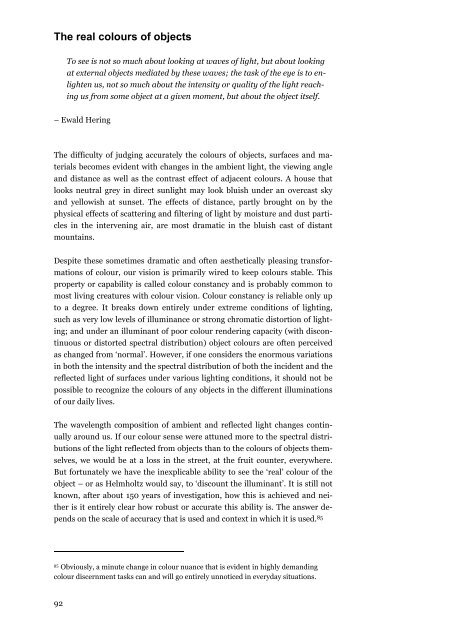Lightness and Brightness and Other Confusions
Lightness and Brightness and Other Confusions
Lightness and Brightness and Other Confusions
You also want an ePaper? Increase the reach of your titles
YUMPU automatically turns print PDFs into web optimized ePapers that Google loves.
The real colours of objects<br />
To see is not so much about looking at waves of light, but about looking<br />
at external objects mediated by these waves; the task of the eye is to enlighten<br />
us, not so much about the intensity or quality of the light reaching<br />
us from some object at a given moment, but about the object itself.<br />
– Ewald Hering<br />
The difficulty of judging accurately the colours of objects, surfaces <strong>and</strong> materials<br />
becomes evident with changes in the ambient light, the viewing angle<br />
<strong>and</strong> distance as well as the contrast effect of adjacent colours. A house that<br />
looks neutral grey in direct sunlight may look bluish under an overcast sky<br />
<strong>and</strong> yellowish at sunset. The effects of distance, partly brought on by the<br />
physical effects of scattering <strong>and</strong> filtering of light by moisture <strong>and</strong> dust particles<br />
in the intervening air, are most dramatic in the bluish cast of distant<br />
mountains.<br />
Despite these sometimes dramatic <strong>and</strong> often aesthetically pleasing transformations<br />
of colour, our vision is primarily wired to keep colours stable. This<br />
property or capability is called colour constancy <strong>and</strong> is probably common to<br />
most living creatures with colour vision. Colour constancy is reliable only up<br />
to a degree. It breaks down entirely under extreme conditions of lighting,<br />
such as very low levels of illuminance or strong chromatic distortion of lighting;<br />
<strong>and</strong> under an illuminant of poor colour rendering capacity (with discontinuous<br />
or distorted spectral distribution) object colours are often perceived<br />
as changed from ‘normal’. However, if one considers the enormous variations<br />
in both the intensity <strong>and</strong> the spectral distribution of both the incident <strong>and</strong> the<br />
reflected light of surfaces under various lighting conditions, it should not be<br />
possible to recognize the colours of any objects in the different illuminations<br />
of our daily lives.<br />
The wavelength composition of ambient <strong>and</strong> reflected light changes continually<br />
around us. If our colour sense were attuned more to the spectral distributions<br />
of the light reflected from objects than to the colours of objects themselves,<br />
we would be at a loss in the street, at the fruit counter, everywhere.<br />
But fortunately we have the inexplicable ability to see the ‘real’ colour of the<br />
object – or as Helmholtz would say, to ‘discount the illuminant’. It is still not<br />
known, after about 150 years of investigation, how this is achieved <strong>and</strong> neither<br />
is it entirely clear how robust or accurate this ability is. The answer depends<br />
on the scale of accuracy that is used <strong>and</strong> context in which it is used. 85<br />
<br />
Obviously, a minute change in colour nuance that is evident in highly dem<strong>and</strong>ing<br />
colour discernment tasks can <strong>and</strong> will go entirely unnoticed in everyday situations.<br />
92
















